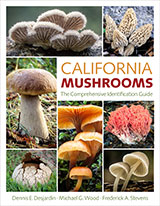The North American Species of Pholiota
18. Pholiota murrillii nom. nov.
Gymnopilus aromaticus Murrill, North Amer. Fl. 10: 203. 1917.
(not Pholiota aromatica Orton, 1960)
Illustrations: Text figs. 477-479.
Pileus about 3 cm broad, convex to expanded, surface conspicuously floccose, areolate with age, yellowish-ferruginous margin lacking striae. Context whitish, aromatic; taste like that of birch twigs.
Lamellae adnexed, crowded, rather narrow, yellow to bright ferruginous.
Stipe 2-3 cm long, 4 mm thick, cylindric, densely yellow-fibrillose, chrome yellow, solid, hard, whitish within.
Spores 7.5-9.5 x 4-5 µ, smooth, apical pore minute and not visible on all spores, shape in face view ovate to elliptic, in profile mostly more or less bean-shaped; color in KOH more or less ochraceous tawny, not appreciably different in Melzer's reagent; wall about 0.3 µ thick.
Basidia 24-30 x 4.5-7.5 µ, 4-spored, narrowly clavate, in KOH lemon-yellow, duller in Melzer's reagent (yellow pigment diffusing copiously in mounts in KOH). Pleurocystidia 26-35 x 3-7 µ, present as pseudocystidia, with dingy yellowish granular content (in Melzer's mounts) and much granular to minutely granular material pervading the mount and the content disappearing from the "pseudocystidia," in KOH the content homogeneous. Cheilocystidia 28-42 x 4-9 µ, versiform: filamentous-subcapitate with a flexuous pedicel, slightly ventricose below and equally broad at apex, subtibiiform as in some species of Galerina, etc., their content yellow to orange-brown in KOH. Caulocystidia 36-48 x 5-8 µ, cylindric-capitate to fusoid-ventricose.
Gill trama subparallel to interwoven, cells 5-12 (finally) with thin smooth walls, the layer bright yellow in KOH; subhymenium of narrow compactly arranged non-gelatinous hyphae also yellow in KOH. Pileus cutis a collapsed trichodermium of non-gelatinous thin-walled smooth hyphae, 6-15 µ diam., with walls ochraceous in KOH (on isolated cells, or in masses of cells fulvous), cells mostly elongated and end-cells clavate to cystidioid; hypodermial hyphae arranged compactly in a layer about the color of the context. Context with an orange-fulvous layer toward the hymenophore of ochraceous somewhat refractive but not gelatinous hyphae above. Clamp connections present. All hyphae inamyloid.
Habit, Habitat, and Distribution: On dead hemlock, New York, August. Type studied.
Observations: This species is distinguished from P. curvipes by its odor and taste, and more subtibiiform cells as caulocystidia. The figures are from the type.

